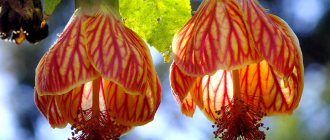Croton or codiaeum is one of the most popular decorative foliage indoor plants. The genus of culture includes 16 species of shrubs and trees of the Euphorbiaceae family.
In nature, representatives of the species grow in the tropical forests of Indonesia, Polynesia, Northern Australia, India and Malaysia.
Codiaum was brought to Europe at the beginning of the 19th century, where it was grown in greenhouses and greenhouses.
Croton bloom
Under natural conditions, trees can reach several meters in height, but indoor croton rarely grows to 1-1.5 meters. The main decoration of a tropical plant is its colorful foliage, which delights gardeners with a variety of shapes and colors.
Leathery, smooth and shiny leaves, depending on the variety and type, can be narrow, lobed, long, short, with smooth or wavy edges.
The foliage of most species has a clear, yellow pattern along the lines of the veins of the leaf blade.
The variegated color of the leaves forms an amazing combination of color shades: green, red, yellow, red, white, pink or brown.
Watering
Croton grows well in slightly moist soil without drying it out. Enough moist soil so that the roots are not literally standing in water. It is better to water a small amount of water in several portions regularly than to pour a large amount at once. By touching the ground with your finger, you can easily determine the humidity. If the soil seems dry, water it again. In cooler temperatures and less light (winter), Croton uses less water, so adjust the amount of water accordingly by watering less.
The amount of water depends, among other things, on temperature and light intensity. With a newly purchased plant or after moving, it is advisable to start with a small amount of water. If the soil is still very wet after 4 days, water less. If the soil becomes dry again after 2 days, water again. By regularly checking the soil for moisture by dipping your finger into it, you will automatically know how often and how much water the plant needs.
Water system
If you fill a houseplant with substrate and equip it with a water meter, the water dosage will change. Water once a week. Pay attention; The water drains slowly, so the water meter responds with a delay. In winter, water once every two weeks.
Spraying
Regular spraying of Croton is necessary to prevent the appearance of spider mites. The more often the better, but at least once a week. When the heater is on, it is recommended at least twice a week.
Taking a warm shower twice a year also provides benefits. To do this, cover the soil with cling film so as not to overwater it. The shower has a preventative effect against pests and removes dust from the leaves. This benefits the houseplant and makes it look more beautiful. A dust-free leaf receives more light, which gives the plant a richer color.
Reproduction technology
Croton propagates under indoor floriculture conditions through cuttings. Decorative crops can be propagated by cuttings almost all year round. For this purpose, it is best to cut off the apical cutting or woody stem cutting 10-12 cm long. The milky sap must be carefully removed from the cut under running water and treated with crushed charcoal and a growth stimulator, after which the cutting must be planted in the soil mixture.
For rooting, a nutrient substrate based on coarse sand with the addition of peat soil is optimal. Measures for caring for cuttings include periodic spraying of plants and moistening the soil. The temperature regime until the stage of complete rooting should be within 24 ° C. It is also allowed to root cuttings of an ornamental crop in water, after which the plant must be transplanted to a permanent place in a flower pot filled with nutritious soil. Crotons are propagated by leaves using the same principle.
Light and warmth
The miracle bush prefers to receive a lot of light. But be careful of direct sunlight during the summer months. Croton is grown in diffused light, avoiding drafts. If it is in front of a south-facing window, it is recommended to maintain a distance of 2 to 3 meters. Gradually the plant can be brought closer to the window.
Croton needs at least 5 hours of good light per day. Therefore, it is advisable to place these indoor plants directly in front of a window in the east, west or north. If there is insufficient light, fresh leaves will not appear and the plant may droop existing leaves. If predominantly dark leaves are present, the indoor plant can be placed a meter closer to the window.
Minimum temperature
| During the day: | 18 ℃ |
| 'At night, in the evening: | 12 ℃ |
Caring for Codiaum Gold Sun.
Temperature. This species requires a warm climate. The best temperature for it varies from +21 to +25. It can withstand +1 8. at excessively cold temperatures, its roots can quickly die. It is especially important to keep Codiaum Gold Sun away from drafts.
Lighting. This type of plant is very sensitive to light, so it should be given as much light as possible.
Watering. Codiaemum Gold Sun really needs water in summer, so you should keep the soil in the pot moist, but not too wet. Excess water should be poured out immediately, as this contributes to the formation of dampness, and dampness contributes to suppuration of the roots. You need to water the plant with warm water.
Air humidity. Codiaeum variegatum Gold San requires tropical humidity. To create a comfortable environment, you can use a humidifier. It must be sprayed daily with warm water and the leaves wiped with a wet sponge. It is also recommended to water the leaves frequently in the shower.
Fertilizer. In summer, the plant grows rapidly. During this period, Kodiemum Gold Sun needs special care and requires feeding. For this, the best option would be liquid fertilizer Ideal and Oasis. Before giving it fertilizer, it is worth watering it thoroughly. In winter, Codiaum (Croton) variegated Gold Sun grows slowly, so it needs to be fed frequently.
The soil. Alkaline soil is suitable for Gold Sun croton. The soil mixture is prepared from peat, coarse sand and humus. Humus is used as a rich fertilizer.
Transfer. The plant can be replanted from store-bought substrate after cleaning the roots. When choosing a pot, you need to choose one that is not very wide. The bottom of the dish must be filled with drainage. The soil should be cleared of pests. Charcoal prevents root rot. The plant needs to be replanted often when it is still young.
Reproduction. Codiaeum variegatum Gold San propagates in spring through cuttings that are found at the top of the plant. The largest ones are selected and cut from the stem and then placed in water to cleanse the poisonous juice. When working, be sure to wear gloves. After drying the cuttings, the shoots should be planted in a pot with damp peat. Roots will begin to appear in a month.
Trimming. To give the plant a more beautiful shape, it needs to be trimmed. The tops of the cuttings can be trimmed to 16 cm. After trimming, it needs to be treated with charcoal so that the tree sap does not expire.
Diseases. This type of plant is rarely susceptible to disease. Its poisonous juice can kill any insect.
Transfer
Replant Croton in the spring or immediately after purchase. Repeat this when the pot becomes too small. This is possible after a year, but usually once every 2 years is sufficient. Replanting is preferable in the spring, since at this time damaged roots are restored faster. Place the houseplant in a pot that is at least 20% wider than the pot it is in, and use regular potting soil. Do not place hydropellets in the bottom if the pot is closed. Stagnant water that accumulates between the grains of the hydraulic system cannot be easily reached by the roots and rotting occurs.
A larger pot encourages growth, improves plant health, and creates a buffer for more water because the soil can absorb more moisture. The latter ultimately simplifies the maintenance of Croton.
Flowering - should it be allowed at home?
According to popular belief, the flowering of croton is considered a bad sign, but this is a superstition. If a flower blooms, then home care is suitable for it. Another thing is that you won’t be able to get seeds for seedlings from one plant, since you need male and female flowers.
In addition, flowering takes a large amount of nutrition and the flower weakens. If you do not take care of feeding in time, it may even die. In order not to risk a mature beautiful plant, the arrow that appears can be cut off and the cut treated with crushed coal.
Trimming
If Croton grows too tall, you can prune it by cutting down the trunk. It is better to do this in spring or summer so that the trunk sprouts again. It is advisable to prune the shoots before each fall so that in winter more light reaches the core of the indoor plant. In spring Croton sprouts again. When trimmed, it will emit a milky white color that can be stopped with coal chips or cigarette ash. Once cut, the trunk will be susceptible to bacterial infections. We recommend sealing the cut with wax or cigarette ash.
How to care for Croton
Question: I want to buy Croton, what difficulties may arise?
Lilu: My croton and I fought for survival for 5 months! At first, dry spots appeared, then the leaf fell off. He was almost completely bald. I sprayed it with epin every week (in addition to daily spraying). He lived under the package for 2 months. Now it stands on a tray with wet expanded clay, has grown a new crown, and has produced leaves and even a twig from the buds on the trunk.
Carina: When I bought my croton, I almost destroyed it. And all he needs is:
- in high humidity (water in the tray, but not in contact with the ground; spray more often; away from heating appliances)
- good lighting (so that the leaves are bright)
- no drafts
- regular watering, without drying out and excess dampness
By the way, high humidity prevents the appearance of a nasty parasite - spider mites! I barely saved my little baby.
Croton - care and cultivation - in the section of the Encyclopedia of indoor plants.
maksim: Those who like to water every other day will have serious problems with crotons, regardless of the time of year or shady location. Sometimes they write that croton tolerates shading but loses color - it’s a fairy tale, everyone with whom I talked, and for me, on 2-3 cloudy days, they stop growing. Another problem is codiaum (croton) - spider mite (treated by spraying - mustard gas). Plus, this tree loves fresh air, but cannot stand cold drafts. And croton also suffers from the soil drying out for a long time - as soon as the leaves begin to fall (wither) - water immediately.
Ann: My croton is about three years old, Gold Star variety. According to observation, he does not really like the bright sun and becomes colorless red. And when it stands in the diffused sun, it is lemon green with bright yellow polka dots. The only question that torments me is how best to form it. For now it is a tree-like plant that constantly produces side branches. If anyone has experience with this type, please share your experience of formation.
Types
Various species of Croton are known. Some varieties: Petra, Mammy, Sunny Star, Tamara, Curly Boy, Excellent and Red Banana.
Croton Petra
The most famous Croton is Petra, this species has the most brightly colored leaves. The great thing about this type of Croton is that the leaf vein is the same color as the leaf, just a brighter color. This gives a pleasant effect.
Croton Norma
Croton Norma has pointed leaves with a glossy surface with a slight depression in the middle. This is an exclusive variety.
Croton Miss Eyeston
The most accessible Croton is Miss Iceton. Unlike Peter, it has no noticeable veins on the leaves, it has a beautiful smooth soft leaf.
Croton Gold Dust
Dark green Croton, with golden yellow speckles. It comes in a variety of colors: yellow, red, copper, green, pink, ivory, orange and brown.
The brighter place you place this Croton, the more spots there will be on its leaves.
Croton Curly Boy
Croton Curly Boy gets its name from its curly leaves and deep red color. This Croton remains relatively dark even if you place it in a lighter location.
Croton Mammy
Croton Mummy - Similar to Curly Boy, but with slightly less curved leaves and more variety in color. The great thing about this Crotona is that it can come in very rich colors.
Croton Codeium Excellent
A dark variety with inconspicuous leaf veins. Croton Kodiema Excellenta has unique leaves, they say if you are very creative, you can see a parrot's head in them.
Botanical description of the plant
Croton (Latin name Codiaeum) is a perennial evergreen plant of the Euphorbiaceae family. In nature, it is found in tropical and subtropical forests of Australia, Oceania (Polynesia), India, as well as some islands of Southeast Asia (Malaysia, Philippines, etc.). Due to the amazing colors of the leaves, the flower is sometimes popularly called “Joseph’s Cloak.”
Did you know? Codiaum is the original name of the plant, probably coined by its discoverer, the Dutchman Georg Rumphius, who studied orchids on the island of Ambon in Indonesia in 1654 and saw the original shrub there. Local residents called the perennial with the beautiful word “kodibo”, although today “codiaum” is rather associated with the Greek “codeia”, which means “head”.
Despite the fact that the plant came to Europe in the second half of the 17th century, the real fashion for it began only three hundred years later. Together with Dieffenbachia and Dracaena, croton initially began to be grown by flower growers from the Netherlands, and from there it began to conquer the world.
When describing the botanical features of codiaum, it is necessary to highlight the following main characteristics of the plant:
| Maximum dimensions | 50–150 cm (in the wild - up to 300 cm) |
| Root system | Powerful, fast growing |
| Stems | Dense, erect, with a large number of lateral processes |
| Leaves | Petiolate. The structure is dense and leathery, with a beautiful gloss. The sizes are large (up to 30 cm in length). The shape can be different (lanceolate, three-fingered, oval, lobed, carved, spiral, often flat, but sometimes with wavy edges). A distinctive feature is a bright and bizarre color: against the main background of any shades of green, there may be stains, veins, stripes, inclusions and other fragments of yellow, white, purple, pink and other contrasting or nuanced colors |
| Inflorescence | Racemose (panicle) |
| Flowers | Small, undecorative, white, yellow or beige with long protruding anthers |
| Fruit | Box with large seeds inside |
Important! Like other Euphorbias, codiaum is poisonous. It is not advisable to keep such a flower for people who have pets (primarily cats). Also, croton juice can cause serious irritation on the skin, so pruning and replanting the plant should be done with protective gloves.
An interesting botanical feature of codiaum is the ability to change the color and shape of leaves depending on environmental conditions. It is on this amazing property that active breeding work aimed at developing new varieties of decorative flowers is based.
Croton formation
Question: Does it need to be pinched for branching, or does it bush on its own? It’s just that it’s still small for me - 12 leaves.
Kroky: If the croton is large-leaved, there is no need to pinch or take cuttings. These produce lateral shoots very poorly (if at all). I had a bad experience with Gold King Croton. My cat decided to “pinch” it. He bit out the growth point. No side leaves appeared, but a new growth point appeared on the top leaf. This happened twice. After the third “pinching”, the croton gave up and began to die. None of my manipulations helped.
Helen: yes, you can, I pinched and trimmed mine, after which they branch, but not profusely. And without pinching or pruning it produces 1 or 2 side shoots in a couple of years of cultivation.
Croton species
Croton laxative (Croton tiglium)
A small shrub or tree up to 12 m tall, evergreen. Leaves are alternate, membranous, ovate with a broadly rounded, sometimes slightly drooping base, pointed, acute or obtuse, very finely serrated, glabrous above, with several star-shaped hairs below, 7.5-17 cm long, 4-9.5 cm wide, from metallic green to bronze or orange. The petiole is thin, about 4 cm long; conditionally yellow, 1.5-3.5 mm long. The inflorescence axis is bare; the flowers are small and inconspicuous. Male flowers are star-shaped and hairy with narrowly elongated petals and 15-20 stamens; female flowers are apetalous; capsule with stellate hairs, triangular, 15-20 mm long, 10-15 mm wide, oblong or ellipsoid, 3-lobed. Seeds 3 per fruit, oblong-ovate, orange, about 12 mm long, smooth
Croton lechleri
It is a flowering plant with a broad but open crown, native to northwestern South America. It grows up to 20 meters in height with a trunk diameter of usually 30 cm. It is also known as Sangre de Drago. It is characterized by thick red latex, which has medicinal properties. It is used as a liquid dressing for wounds and other skin injuries and disorders. It is an effective antiviral treatment and is also used in the treatment of tumors.
Variegated Croton (Croton variegatum)
With its gorgeous foliage in rich fall colors, garden croton exudes living space comfort and good cheer. Fine varieties of this species with impressively decorative leaves also serve as a refreshing air freshener. It's no surprise that the tropical, evergreen ornamental plant is at the top of the list of most popular houseplants. The most
How does Croton grow?
Question: I bought a little croton while the leaf developed during the adaptation period. This was followed by replanting (most likely transshipment), soil, watering, habitat (eastern window) everything was normal! There are no drafts! The root is normal! The roots are whitish and elastic. But for some reason it stood still all summer and didn’t produce a single leaf! What is the problem and how to deal with it?
Kroky: If you take good care of it, spray it, the water doesn’t stagnate, it drinks normally, it doesn’t shed leaves, then I personally don’t see a problem. Croton can grow in spurts, produce 2-4 leaves, freeze for a while, etc. Patience!
Question: Do crotons bloom? Looks like my young croton is starting to form a bud.
Innusik: This is how my croton Excelent (large) blooms.
irina-bahus: Mine bloomed once, last year and didn’t indulge this year, but at first my male “flowers” came out - there were large drops of syrup on the stick, in some modified sepals (apparently), and after two weeks it came out the second branch, and there were balls on it. After much torment, I tried the syrup and ended up devouring it all - it turned out to be very tasty. And then croton has two types of flowers, maybe your underdeveloped leaf is an unsuccessful attempt at a male inflorescence? Because the fluffy balls are definitely feminine.
Buttercup: If your croton is still weak, then it’s better not to let it bloom. Flowering still requires additional strength from plants.
Question: I want to buy a little croton. How fast do they grow? Does it make sense to buy a small plant?
irina-bahus: Unfortunately, crotons grow quickly, I would even say, very quickly. Some can be controlled by pinching, but some will still grow no matter what. So it’s better to buy a small one; you’ll have time to think about what to do with it later.
Question: Is it true that crotons change color and what does this depend on?
irina-bahus: Crotons definitely need light, and as much as possible. The variegated form changes color depending not only on light, but also on age. On my large croton, which is Exellent, the leaves are red below, yellow in the middle, and very young green on top.
Question: What should I add to a croton that is bald from below? I was thinking about some peperomia or ficus “sunny”. Will such replanting harm the croton?
Buttercup: Ficus “Sunny” should not be made as ground cover, because it has very strong roots and drowns out others. My croton coexisted well with Crassula and Fittonia.
Croton soil
Question: I bought a croton, do I need to replant it or is it enough to transship it, and in what land?
Kroky: Take universal soil from the store, add vermiculite to it (a fifth), and a slightly larger pot (2-3 cm in diameter), store-bought ones are usually of such a size that it is not clear how the flower was stuffed there. The method of transplantation is a matter of taste and the condition of the roots. If the roots are normal, shake off the earthen ball a little and plant the croton. After transplantation, spray with epin - it is an immune system stimulant.
Ann: The soil for croton is the most common - this plant is not picky about the soil, as long as it does not turn sour (covered with a salt coating). You can take garden soil, but add more vermiculite to it, about 1/4 of the total mass. If you buy soil for croton in a store, choose the one for palm trees, ficus, and monstera. Don't forget about drainage at the bottom of the pot!
Question: What kind of pots do crotons like: shallow or deep? My croton grows so slowly, although the color is juicy, and the leaves seem to be on different levels - one floor has large leaves, the second has small ones, and so they alternate. I think maybe the pot has become too small?
irina-bahus: He doesn’t need a small pot, a regular one will do. Only proportionate to the roots - in a large pot there is a very high probability of flooding. My Gold Star croton grows slowly, too, but Exellent grows quickly. Maybe this is a feature of the variety.
Mite on croton
Question: I left 3 weeks ago - he produced 4 luxurious green leaves, 2 not quite large ones and 2 more rudiments of leaves. And today I see: all the leaves are burgundy instead of green, those leaves that were going to grow turned yellow about 1 cm and fell off. At the same time, the old leaves in the middle remained green and burgundy. Is it good or bad?
Kroky: I suspect it's a tick. As it happened to me - when rearranging, a leaf fell out from the middle of the crown, it seemed like nothing special, but upon closer examination there were spots on the outside and inside (there are white dots on the underside of the leaf, they can be removed by hand), and on the inside pit. And on a young leaf that was still green, I noticed a strange purple spot. This is a tick, it adds such a purple tint.
Tishka: If there are spots like from a needle prick, it’s a tick. This often happens especially after the store. Spray it with any anti-mite preparation, because washing it is useless (the leaves of this croton are wavy and it is almost impossible to wash it well).
Croton: types and varietal range of plants with the most variegated leaves
Croton belongs to the genus Euphorbiaceae, which contains about 1,300 species, widely distributed in the tropical regions of the New and Old Worlds. The plant is best represented in the Americas, with about 65 species found in continental Africa and about 125 in Madagascar. This plant grows in an assortment of shapes and colors, including red, orange, purple, pink, yellow, green and white.
Outdoors, crotons grow as fun container plants, accenting other favorites such as lantana, angelonia and pentas. In warm, frost-free climates, crotons grow as living landscape shrubs. They are often used as dramatic hedges or colorful accents in the yard. Of the long list of widows, only variegated croton is suitable for indoor growing. Several hybrid varieties have been bred on its basis; their photos can be found in the catalogs of many stores.
Croton leaves are falling
Question: The lower leaves fall off as they age, is this correct or not? The trunk is exposed. Well, then he will become completely naked?
Maslinnitsa: This happens in winter and there can be several reasons: dry air, draft, low light. Check for pests (just in case). For several years, not a single bottom leaf has fallen at all for the entire year.
Question: What to do if the croton (codium) has a bare trunk at the bottom. Where the leaves have fallen off, new ones will no longer grow? So maybe then cut off the top and plant it?
Carina: I would not advise you to cut off the top and root it. I tried to root the tops of croton many times. Not a single one took root. Croton is very difficult to root at the top, especially if it is massive with burdock leaves! But you can root a side shoot; if there is one, it will give roots better. To prevent the croton trunk from becoming exposed from below prematurely, you need to spray it more often and not overdry it; the worst damage is caused by the air from central heating. Of course, the leaves will not grow in the same place, but perhaps in these places your croton will begin to branch.
irina-bahus: The lower leaves fall off due to lack of moisture, nothing can be done about this, but you can plant something short and fluffy underneath.











